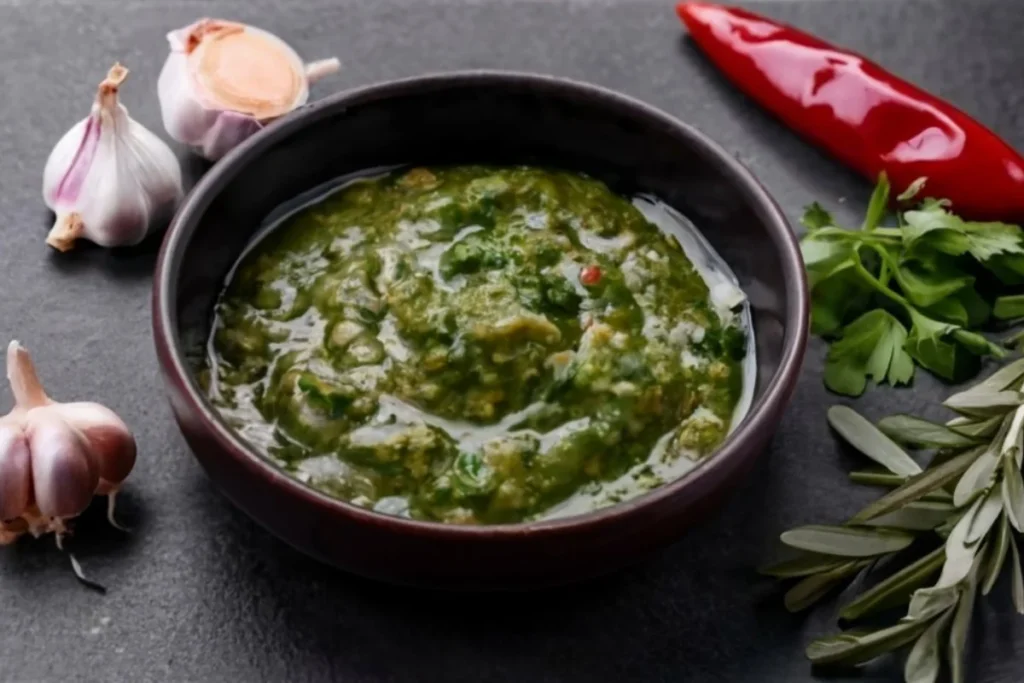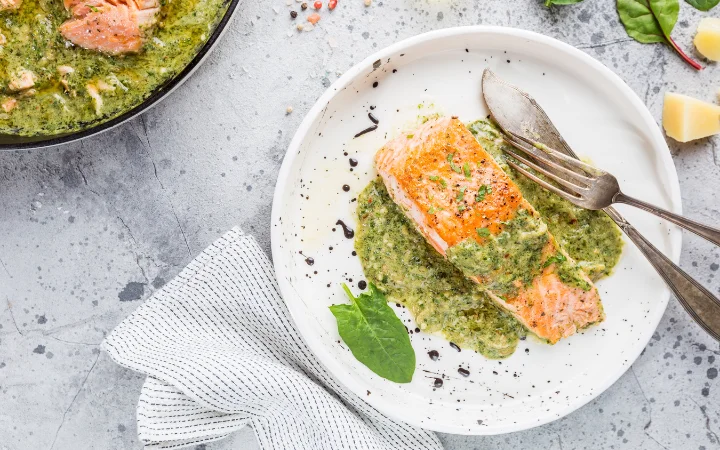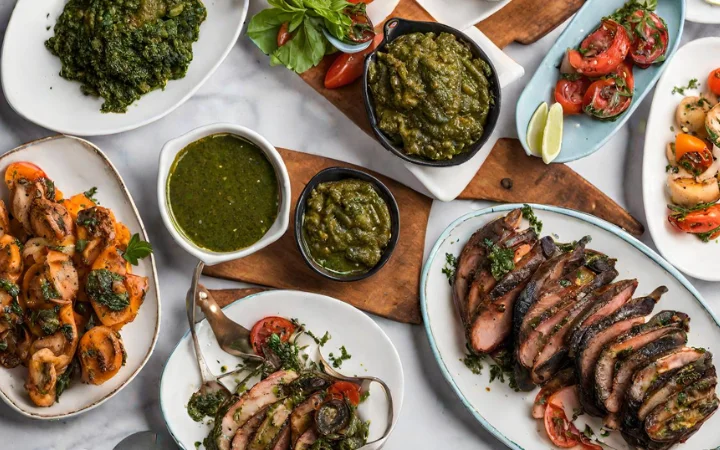In this comprehensive guide, we’ll dive into the vibrant world of chimichurri sauce, exploring its origins, culinary uses, and the myriad ways it can enhance your meals. From traditional pairings to modern adaptations, health benefits, and even a step-by-step recipe, this article covers everything you need to know about this flavorful, herb-based condiment.
Introduction to Chimichurri Sauce
Chimichurri sauce, a staple in South American cuisine, particularly in Argentina and Uruguay, is a tantalizing blend of fresh herbs, garlic, olive oil, and vinegar.Discover the ultimate guide to Argentina’s flavorful sauce. This zesty sauce is not just a culinary delight but also a reflection of the rich cultural heritage of its regions.
Origin and Cultural Significance
Chimichurri’s roots are deeply embedded in the gastronomic traditions of South America, with various legends about its birth and evolution. Learn more about the history of chimichurri sauce. It’s believed to have originated in Argentina and Uruguay, where it’s a beloved accompaniment to barbecued meats, especially steak. The sauce’s name, chimichurri, is as intriguing as its flavor, with several theories about its origin adding to its mystique. Some say it’s derived from the Basque word “tximitxurri,” meaning “a mixture of several things in no particular order,” perfectly capturing the essence of this versatile sauce.
Basic Ingredients and Variations
At its core, chimichurri is a simple yet bold combination of finely chopped parsley, minced garlic, olive oil, and red wine vinegar.Variations often include cilantro, oregano, and a hint of chili for an extra kick, offering a delightful twist to the traditional recipe. Explore different chimichurri sauce recipe variations. While the green version is more common, a red chimichurri, incorporating ingredients like red bell peppers or tomatoes, offers a delightful twist. Each ingredient plays a crucial role, with the fresh herbs providing an herbaceous base, garlic adding pungency, olive oil bringing richness, and vinegar lending a tangy edge. This harmonious blend results in a sauce that’s not only a flavor enhancer but also a testament to culinary creativity.

In the next section, we’ll explore the various culinary uses of chimichurri sauce, showcasing its versatility in both traditional and modern dishes. Stay tuned for a journey through flavors that will transform your cooking experience!
Culinary Uses of Chimichurri Sauce
Chimichurri sauce, with its vibrant flavors, has become a global sensation. Its versatility allows it to complement a wide range of dishes, making it a favorite among chefs and home cooks alike.
Traditional Pairings in South American Cuisine
In its homeland, chimichurri is synonymous with asado, the famous South American barbecue. It’s the perfect partner for grilled meats like beef, pork, and lamb. The sauce’s bright, tangy profile cuts through the richness of the meat, creating a balance that’s simply irresistible. In Uruguay and Argentina, no barbecue is complete without a generous helping of chimichurri. It’s not just a condiment; it’s a celebration of flavor and tradition.
Modern Adaptations and Fusion Dishes
Chimichurri’s journey doesn’t stop at traditional dishes, as chefs have embraced its bold flavors in various cuisines. Discover modern adaptations of chimichurri sauce. Chefs around the world have embraced its bold flavors, incorporating it into a variety of cuisines. It’s fantastic on grilled vegetables, making it a hit with vegetarians and vegans. You can also find it in sandwiches, wraps, and even as a zesty salad dressing. Its adaptability has led to exciting fusion dishes, where chimichurri meets other culinary traditions, creating new taste sensations. From topping gourmet burgers to enhancing pasta dishes, chimichurri continues to surprise and delight food enthusiasts everywhere.

In the next part, we’ll share a step-by-step recipe to prepare your own chimichurri sauce. Plus, we’ll offer tips to achieve the perfect consistency and flavor. Get ready to add this culinary gem to your kitchen repertoire!
Preparing Chimichurri Sauce
Creating your own chimichurri sauce is a delightful and straightforward process. Learn more about chimichurri seasoning and its origins. With just a few fresh ingredients and simple steps, you can whip up this flavorful condiment in no time.
Step-by-Step Recipe
Firstly, gather fresh parsley, garlic, olive oil, and red wine vinegar. Optionally, add cilantro, oregano, and a pinch of chili for extra zest. Finely chop the parsley and garlic (or use a food processor for convenience). Next, combine these with olive oil and vinegar in a bowl. If you’re using cilantro and oregano, chop them finely and mix them in. For a spicy kick, add the chili. Let the mixture sit for a few minutes, allowing the flavors to meld beautifully. And there you have it, your homemade chimichurri is ready to elevate your dishes!
Tips for Perfect Consistency and Flavor
For the best results, use fresh herbs; they’re key to chimichurri’s vibrant taste. Also, adjust the garlic and chili to suit your palate. Remember, start with less and add more as needed. It’s easier to add than to subtract flavors. If the sauce is too thick, a splash of water can help. Letting the sauce rest before serving allows the flavors to develop fully. Store any leftovers in the fridge, and enjoy the enhanced taste over the next few days.

In the next part, we’ll explore the best pairings for chimichurri sauce, from meats to vegetarian options. Get ready to discover new ways to enjoy this versatile sauce!
Chimichurri Sauce Pairings
Chimichurri sauce, renowned for its versatility, pairs wonderfully with a wide array of dishes. Whether you’re a meat enthusiast or a vegetarian, this sauce adds a burst of flavor to any meal.
Best Meats for Chimichurri
Traditionally, chimichurri shines brightest when served with grilled or barbecued meats. It’s a match made in heaven for steaks, enhancing their rich flavors with its herby and tangy notes. Similarly, it complements grilled chicken, pork, and lamb beautifully. The sauce’s acidity and herbaceousness cut through the fattiness of the meat, creating a harmonious balance. Moreover, it’s equally delightful on seafood, such as grilled shrimp or fish, adding a fresh and zesty dimension.
Vegetarian and Vegan Options
Furthermore, chimichurri isn’t just for meat lovers. Try this flavorful chimichurri salmon recipe for a culinary adventure. It’s a fantastic addition to grilled or roasted vegetables, bringing a new level of taste to dishes like grilled zucchini, bell peppers, or eggplant. Additionally, it’s a superb topping for baked potatoes or mixed into a hearty grain salad. For vegans, chimichurri can be a game-changer, transforming simple tofu or tempeh dishes into flavor-packed meals. Its versatility also extends to being a vibrant dressing for green salads, adding a punch of flavor to every bite.

In the next part, we’ll explore the health benefits and nutritional profile of chimichurri sauce. Prepare to be surprised by the wholesome goodness packed in this simple yet powerful condiment!
Health Benefits and Nutritional Profile
Chimichurri sauce is not only a feast for your taste buds but also a boon for your health. Packed with fresh ingredients, it offers numerous nutritional benefits.
Nutritional Components of Chimichurri
Primarily, chimichurri is made from fresh herbs like parsley, which is rich in vitamins and antioxidants and offers numerous health benefits. Learn about the health benefits of parsley. These herbs contribute to a healthy immune system and offer anti-inflammatory properties. Additionally, garlic, a key ingredient, is known for its heart-healthy benefits and ability to lower blood pressure. Olive oil, another essential component, is a source of healthy fats and has been linked to reduced risk of heart diseases. Moreover, the garlic in chimichurri not only adds a pungent flavor but also has heart-healthy benefits. Discover the health benefits of garlic.
Furthermore, the combination of these ingredients in chimichurri makes it a nutrient-dense sauce. The antioxidants present in the herbs help combat free radicals, promoting overall health. The anti-inflammatory properties can be beneficial for those with inflammatory conditions.Besides, the healthy fats from olive oil are crucial for brain health and maintaining healthy cholesterol levels. In addition, the low-calorie nature of chimichurri makes it an excellent choice for those watching their weight, without compromising on flavor.
In the next part, we’ll answer some frequently asked questions about chimichurri sauce, providing you with expert insights and tips.
FAQs About Chimichurri Sauce
Chimichurri sauce, with its growing popularity, naturally raises questions among food enthusiasts. Here, we address some of the most common inquiries to enhance your understanding and enjoyment of this delightful sauce.
Common Questions and Expert Answers
- What is the best way to store chimichurri sauce?
To maintain its freshness, store chimichurri in an airtight container in the refrigerator. It can last up to a week, and interestingly, the flavors often deepen over time. - Can chimichurri sauce be frozen?
Absolutely! Freezing chimichurri is a great way to preserve it. Pour the sauce into ice cube trays, freeze, and then transfer the cubes to a freezer bag. Use them as needed to add instant flavor to dishes. - Is chimichurri sauce spicy?
Typically, chimichurri has a mild heat. However, you can adjust the spiciness to your liking by controlling the amount of chili or red pepper flakes. - Can I make chimichurri without cilantro?
Certainly! While cilantro adds a unique flavor, it’s not essential. You can make a delicious chimichurri with just parsley, or try other herbs like oregano or mint for variation. - What are some creative ways to use chimichurri?
Besides the traditional uses, try it as a marinade for meats, a spread for sandwiches, or even a zesty addition to soups and stews. Its versatility knows no bounds!
In the final part of our article, we’ll wrap up with some concluding thoughts on chimichurri sauce, celebrating its rich flavors and diverse applications.
Conclusion and Final Thoughts
In conclusion, chimichurri sauce is a remarkable culinary creation that transcends borders and brings a burst of flavor to a multitude of dishes.Its simple yet potent combination of fresh herbs, garlic, olive oil, and vinegar has captured the hearts of food lovers worldwide.
Reflecting on our journey through the world of chimichurri, we’ve seen its versatility in traditional and modern cuisine, its ease of preparation, and the delightful pairings it offers for both meat and vegetarian dishes. Moreover, the health benefits and nutritional value of chimichurri make it a guilt-free addition to any meal.
Chimichurri sauce is more than just a condiment; it’s a celebration of flavor, culture, and culinary innovation, offering a burst of flavor to a multitude of dishes.Explore the versatility of chimichurri sauce. Whether you’re grilling steaks, roasting vegetables, or simply looking for a way to spice up your salads, chimichurri is a go-to sauce that promises to elevate your dishes to new heights.

Embrace the vibrant flavors of chimichurri and let your culinary creativity soar. The possibilities are endless, and the results are always delicious!
